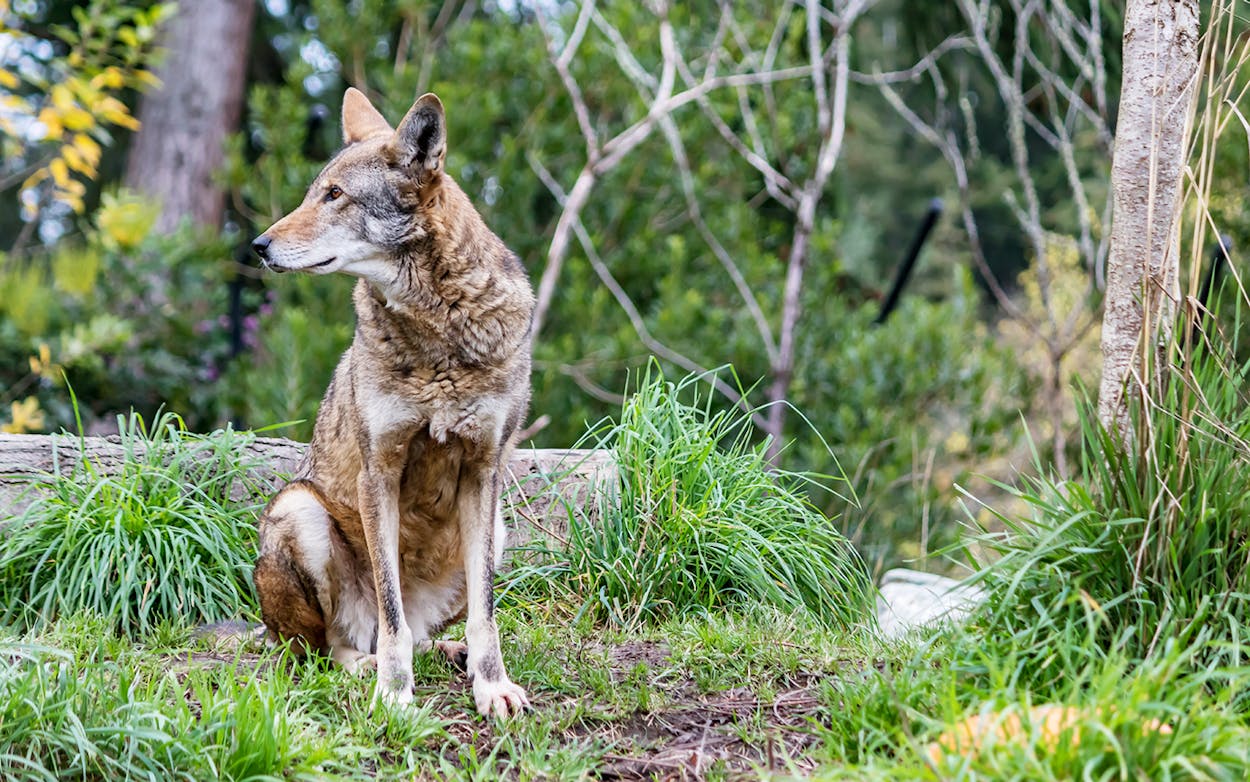The red wolf was declared extinct in the wild in 1980, and while forty or so red wolves were captured, bred in captivity, and reintroduced into the wild in North Carolina in 1990, there have been mysterious unconfirmed reports of red wolf sightings scattered along the Texas Gulf Coast for decades. Those sightings were typically dismissed—scientists were certain coyotes were being mistaken for the elusive wolf. But now there’s some evidence indicating that red wolves may actually have a genetic presence along the coast in Texas.
It all began with some roadkill. Biologist and photographer Ron Wooten had been photographing coyotes on Galveston Island in 2013 when he realized some of the dogs did not look like “normal coyotes,” Wooten told KRIV. He found two of the “coyotes” dead along the road, took some samples, and stashed them in his freezer, hoping to have them genetically tested. Several agencies turned him down, so he reached out to Bridgett vonHoldt, a biologist at Princeton University. “I regularly receive this kind of inquiry, but something about Wooten’s email stood out,” vonHoldt said later, according to a December press release from Princeton. “His enthusiasm and dedication struck me, along with some very intriguing photographs of the canines. They looked particularly interesting and I felt it was worth a second look.”
The second sample Wooten sent was somehow lost, and according to the press release, Wooten sent the scalpel he had used to take the sample as a makeshift replacement. “No one had ever sent us a scalpel before, so it was a pretty memorable experience trying to extract this DNA,” Elizabeth Heppenheimer, a graduate student in vonHoldt’s lab, said. From the press release:
Once the researchers extracted and processed the DNA, they compared the samples to each of the legally recognized wild species of the genus Canis that occur in North America. They used samples from 29 coyotes from Alabama, Louisiana, Oklahoma and Texas; 10 gray wolves from Yellowstone National Park; 10 eastern wolves (C. lycaon) from Algonquin Provincial Park in Ontario; and 11 red wolves from the red wolf captive breeding program. When they ran their genetic analyses, they found that the Galveston Island animals were more similar to captive red wolves than typical southeastern coyotes.
The finding shocked Heppenheimer. “I think we were all genuinely surprised that there was any indication of red wolf genes in either of these samples,” she said, according to the press release. “We get odd samples shipped to us fairly regularly, and most of the time they turn out to be coyotes. … Initially I was extremely skeptical that the analysis would turn up anything interesting, which in the end turned out to be very humbling. I think of myself as an expert on these animals, but in reality most of the time I’m just looking at my computer. It’s the people on the ground, who watch these animals regularly, who have made the major discovery.”
Wolves and coyotes typically don’t breed with each other, unless they are both in such low populations that they have to choose between interbreeding or not breeding at all. Because of the genetic mixing, the canines on Galveston that contain red wolf DNA are “ambiguous-looking,” Heppenheimer said. But it’s a welcome find for the biologist community. “It’s incredibly rare to rediscover animals in a region where they were thought to be extinct, and it’s even more exciting to show that a piece of an endangered genome has been preserved in the wild,” Heppenheimer said. The scientists recently published an article about their discovery in the journal Genes.
The timing of the discovery is critical, as the red wolves that were reintroduced into the wild in North Carolina are disappearing. As the Associated Press reports, a U.S. Fish and Wildlife Service review in April found that the North Carolina wolf population had dropped to forty, down from a peak of about 120 ten years ago. “The population cannot recover from their losses and overcome mortality resulting in a steadily declining population,” the review states, adding that the population of wild wolves might vanish within a decade.
According to the AP, federal statistics show that humans are mainly responsible for wolf deaths. More than 80 wolves died from gunshot wounds over a 25-year period ending in 2013, while about 70 wolves were killed by cars. By comparison, the leading natural cause of wolf deaths was health-related problems, which accounted for nearly 60 deaths. The Fish and Wildlife Service has faced criticism from biologists for its handling of red wolves, and the agency was sued by a group of conservationists over its recent abandonment of what had been a successful management strategy. In November, a federal judge ruled that the Fish and Wildlife Service violated the Endangered Species Act and the National Environmental Protection Act by neglecting its duty to protect the animal in North Carolina. The judge noted in his decision that the stark decrease in wolf population coincided with arbitrary policy changes by the USFWS that halted the protection of newborn pups and the introduction of new wolves into the wild, and with a policy shift that allowed landowners to shoot wolves that wandered onto their property.
The discovery of red wolf DNA in Galveston has scientists hopeful that the animal can survive in the region, which may make it a potential arena for future red wolf reintroduction efforts, the scientists wrote in Genes. The discovery also means there’s hope the red wolf may live on in genetic form, even if the pure animal ceases to exist in the wild. “Through interbreeding with coyotes, this endangered genetic variation has persisted and could represent a reservoir of previously lost red wolf ancestry,” the scientists wrote in Genes. “This unprecedented discovery opens new avenues for innovative conservation efforts, including the reintroduction of red wolf ghost alleles to the current captive and experimental populations.”






